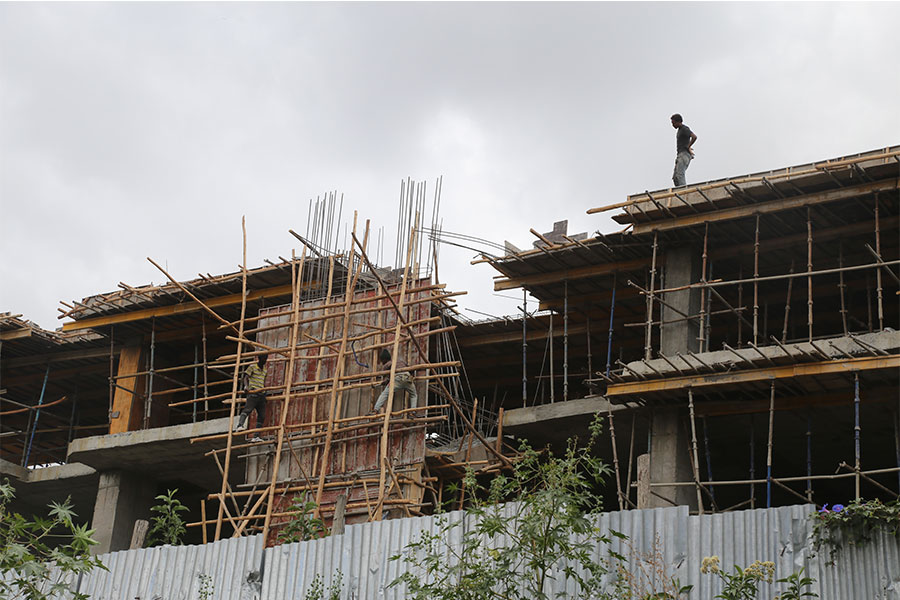
Dec 21 , 2019
By MESAY BERHANU ( FORTUNE STAFF WRITER
)
The recently inaugurated headquarters building of Dashen Bank turns out to be the first bank in the capital to receive a fire safety standards certificate.
Located in front of the National Bank of Ethiopia on Sudan Avenue, the building received the certification from the Addis Abeba Fire & Disaster Risk Management Commission on November 19, 2019. The certification is valid for a year, and it should be renewed annually.
The Commission has previously granted the same certificate for the hotels in the capital that earn star ratings. However, other buildings in the city including banks do not have this certificate.
The building is equipped with a complete fire extinguishing system with fire exits, reserve water, and a smoke, heat and gas emissions system, according to Habtamu Eba (Com.), security manager at Dashen, which was established 24 years ago.
Dashen headquarters has a central security station managed by staff that are mainly trained for the operations, according to Habtamu.
"The staff of the Bank also received training on basic fire safety measures," Habtamu told Fortune.
Inaugurated last year, the headquarters has 21 storeys, was constructed for a little over a billion Birr, and sprawls over 3,495Sqm of land. MIDROC Construction constructed the building.
Most of the buildings in the city do not consider safety standards in the building code, according to Edomiya Tiruneh, institutional safety inspection and certification team leader at the Commission.
Building Code Standards, which were prepared by the Ministry of Construction & Housing Development in 2014, stipulated precautionary fire measures to be duly considered in building design, construction and use.
Office buildings, hotels and manufacturing companies, including textile factories and chemical industries, have different criteria and standards of safety requirements depending on the level of heat they generate in their operations.
Accordingly, the standards require the availability of automatic sprinklers and FM200 gas, a fire suppression substance used to extinguish the fire by removing oxygen and heat elements from buildings during an emergency. It also requires the availability of 115 to 150 cubic metres of reserve water stored within the building structures. The standards mandate buildings have a fire pump if they are above two floors.
Institutions are required to keep fire safety equipment such as fire hoses, dry chemical extinguishers and foam near meeting halls, parking areas and close to gas and chemical storage facilities. They are also expected to prepare and put an emergency response and evacuation plans in place.
“The presence of trained human resources is also mandatory to effectively use safety systems whenever the need may arise,” says Edomiya.
Usually, building owners themselves apply to the Commission for safety standard inspection and certification. A team of professionals will be dispatched to inspect the buildings based on the specific criteria outlined in the directives.
However, Abraham Assefa (PhD), an assistant professor at Addis Abeba Institute of Technology and a resident engineer for the Commercial Bank of Ethiopia’s new headquarters construction project, observed a lack of coordination between government institutions in enforcing the implementation of the code.
"The existing institutional setup and capacity may not be adequate to enforce the implementation of the safety code effectively," said Abraham.
Edomiyas said that the Commission also advises and provides technical support to under-construction buildings, though it could not yet enforce compliance as a mandatory requirement as part of the licensing process for the construction of new buildings.
“This is a crucial gap that needs to be addressed in the revised regulatory framework for fire safety,” Edomiyas stressed.
The Commission has already drafted a fire code and tabled it to City Council for approval, however, it was not approved yet, disabling the Commission from forcing building owners to acquire fire safety standards.
PUBLISHED ON
Dec 21,2019 [ VOL
20 , NO
1025]

Fortune News | Feb 22,2020

Radar | Apr 30,2022

Fortune News | Apr 26,2019

Radar | Nov 27,2021

Radar | Dec 05,2018

Dec 22 , 2024 . By TIZITA SHEWAFERAW
Charged with transforming colossal state-owned enterprises into modern and competitiv...

Aug 18 , 2024 . By AKSAH ITALO
Although predictable Yonas Zerihun's job in the ride-hailing service is not immune to...

Jul 28 , 2024 . By TIZITA SHEWAFERAW
Unhabitual, perhaps too many, Samuel Gebreyohannes, 38, used to occasionally enjoy a couple of beers at breakfast. However, he recently swit...

Jul 13 , 2024 . By AKSAH ITALO
Investors who rely on tractors, trucks, and field vehicles for commuting, transporting commodities, and f...

Oct 25 , 2025
The regulatory machinery is on overdrive. In only two years, no fewer than 35 new pro...

Oct 18 , 2025
The political establishment, notably the ruling party and its top brass, has become p...

Oct 11 , 2025
Ladislas Farago, a roving Associated Press (AP) correspondent, arrived in Ethiopia in...

Oct 4 , 2025
Eyob Tekalegn (PhD) had been in the Governor's chair for only weeks when, on Septembe...